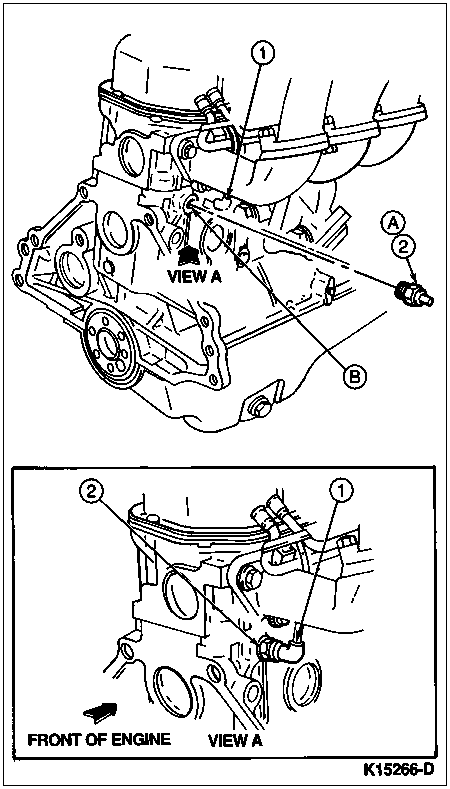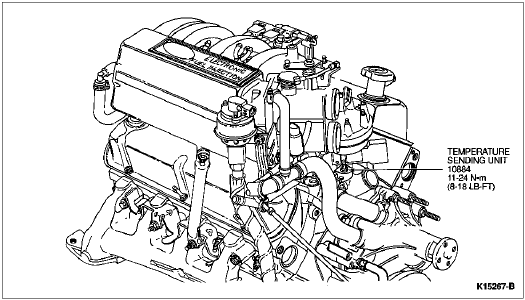![]() CAUTION: Do not remove the radiator cap (8100) on a hot engine.
CAUTION: Do not remove the radiator cap (8100) on a hot engine.
Remove radiator cap to relieve any pressure and then replace radiator cap. This reduces coolant loss during sender replacement.
Section 03-03: Engine Cooling | 1996 F-150, F-250, F-350, F-Super Duty, Bronco Vehicles and F-250, F-350 and F-Super Duty Vehicles with 7.3L Diesel Engines Workshop Manual |
Removal
![]() CAUTION: Do not remove the radiator cap (8100) on a hot engine.
CAUTION: Do not remove the radiator cap (8100) on a hot engine.
Remove radiator cap to relieve any pressure and then replace radiator cap. This reduces coolant loss during sender replacement.
Disconnect the temperature sending unit wire at the sending unit.
Installation
Prepare the new temperature sending unit for installation by applying the Pipe Sealant with Teflon® D8AZ-19554-A or equivalent meeting Ford specification WSK-M2G350-A2, or a small amount of electrically conductive sealer to the threads.
Remove the temperature sending unit from cylinder head (6049) and immediately install the new temperature sending unit. Tighten to 11-24 Nm (8-18 lb-ft).
Connect the wire to the temperature sending unit.
Refill cooling system to replace lost coolant.
Start the engine and check the sending unit operation.

| Item | Part Number | Description |
|---|---|---|
| 1 | — | Temperature Sending Unit Connector (Part of 14289) |
| 2 | 10884 | Temperature Sending Unit |
| A | — | Tighten to 11-24 Nm (8-18 Lb-Ft) |
| B | — | Apply Pipe Sealant with Teflon® D8AZ-19554-A or Equivalent Meeting Ford Specification WSK-M2G350-A2 to Hole Prior to Installation. |

7.3L Diesel
Removal
Disconnect the temperature sending unit wire at the water temperature indicator sender unit (10884).
Installation
Prepare the new water temperature indicator sender unit for installation by applying the Pipe Sealant with Teflon® D8AZ-19554-A or equivalent meeting Ford specification WSK-M2G350-A2, or a small amount of electrically conductive sealer to the threads.
Remove the water temperature indicator sender unit from cylinder head and immediately install the new water temperature indicator sender unit. Tighten to 11-24 Nm (8-18 lb-ft).
Connect the wire to the water temperature indicator sender unit.
Refill cooling system to replace lost coolant.
Start the engine (6007) and check the sending unit operation.